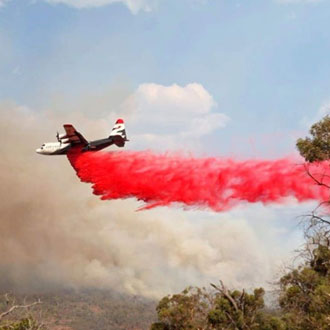Coronastream: a backdrop of fire, smoke and ash
Posted on February 15, 2021 by Dr Tim Inglis
In this special blog series, medical microbiologists led by Dr Tim Inglis summarise some of the research that will be essential to inform COVID-19 countermeasures. Find out more about the project in Dr Inglis' Editorial 'Logic in the time of coronavirus', published in the Journal of Medical Microbiology.

There is little satisfaction in predicting disaster, least of all when it happens so quickly. The very week the January instalment of this blog was posted online, a guard in a local quarantine hotel returned a positive SARS-CoV-2 test and brought the State's 10-month COVID-19-free run to an abrupt halt. Our Health Department moved quickly to introduce a five-day snap lockdown, including compulsory mask-wearing. To add complexity to our troubles, the unusually dry January ended with an enormous bushfire in the Perth hills. In apocalyptic scenes, fire crews went in to battle the blaze in difficult terrain, while mask-wearing families headed for evacuation centres against a backdrop of fire, smoke and ash. Helicopters and planes laying fire retardant gave us a picture of what we're trying to do with our strict border quarantine. But as we found out when SARS-CoV-2 variant B.1.1.7 probed the quarantine system, what worked throughout 2020, may not cope with an evolving coronavirus threat. As for the bushfires, fire and emergency services (DFES) contained the fire, but it was only extinguished when drenching rain came through at the end of the week. If hotel quarantine is a pandemic retardant, we hope that the vaccines are an equivalent of drenching rain.
At the time of writing, the snap lockdown eased after five days and no cases had been detected outside quarantine hotels. A cautious relaxation of precautions was set for another week to guard against late surprises and was widely recognised as the preferable course of action. This response to a single case is a small price to pay for preservation of a COVID exclusion zone, but it is tacit recognition of persisting vulnerability to a second pandemic wave, as experienced in Victoria last year. Transmission of COVID-19 in a Melbourne quarantine hotel, shortly afterwards the Perth incident, raised legitimate questions about aerosol transmission of the B.1.1.7 variant. This time around, Western Australia benefited by seamless progression from rt-PCR to viral genome sequencing and communication back to Public Health Emergency Operations. But like Waterloo, it could have had a very different outcome.
This month, we take a closer look at rapid antigen tests, SARS-CoV-2 variants of concern, return to ACE2 and mark a randomised controlled trial of one of the earlier vaccine candidates.
Congruence: diagnostic utility of rapid antigen tests
COVID-19: Rapid Antigen detection for SARS-CoV-2 by lateral flow assay: a national systematic evaluation for mass-testing
In this, preprint (which has not yet been peer reviewed), Peto and colleagues analyse the performance of SARS-CoV-2 lateral flow devices. Four of 64 tests have shown promising performance in independent laboratory studies. One of these has been assessed in field trials, demonstrating 78.8% viral antigen detection sensitivity, a false positive rate of 0.32% and a kit failure rate of 5.6%. The call for further work on these infrastructure light methods reflects a wider reticence to endorse point-of-care friendly in vitro diagnostic tests, despite a growing recognition of the value of often repeated simpler tests (see Resources, below). The work of the Lateral Flow Oversight Team should help us map a pathway between initial screening for SARS-CoV-2 and subsequent definitive laboratory workflow.
Consistency: ECDC reports their risk assessment of variants of concern
Risk related to the spread of new SARS-CoV-2 variants of concern in the EU/EEA
This risk assessment from the European Centre for Disease Prevention and Control (ECDC), summarises what is known about three variants of concern (VOCs), 202012/01,501Y.V2 and variant P.1. 202012/01, known also as B.1.1.7, was first detected in September 2020 and came to prominence in southern England the following December, where it became the dominant type. Its increased transmissibility has led to increasing incidence and pressure on hospitals, and thus, mortality. Variant 501Y.V2 now dominates South Africa where it was first recognised in December 2020. Less is known about variant P.1 which originated in the Amazonia region of Brazil. All three VOCs have a collection of mutations that enhance transmissibility and epidemic potential.
Cumulative dissonance: expression, trafficking and internalisation of ACE2
Nascence, trafficking, and SARS-CoV-2 pathogenesis: the saga continues
In this review, Badawi and Bassam consider the fate of newly synthesised Angiotensin Converting Enzyme 2 (ACE2) molecules; a key receptor for SARS-CoV-2 spike glycoprotein and subsequent viral internalisation. ACE2 membrane targeting, shedding and cell trafficking pathways are identified by the authors as a gap in the current literature. They believe, that ACE2 missense variations could explain some of the variation in COVID-19 severity.
Curtailment: randomised controlled trial of Sputnik vaccine, interim report
Safety and efficacy of an rAd26 and rAd5 vector-based heterologous prime-boost COVID-19 vaccine: an interim analysis of a randomised controlled phase 3 trial in Russia
In this interim report on a phase 3 efficacy and safety trial of a recombinant adenovirus vaccine candidate Gam-COVID-Vac (Sputnik), Logunov and colleagues describe their preliminary results. 19,866 adult subjects received either the vaccine or a placebo in a randomised controlled trial, in which PCR-confirmed SARS-CoV-2 infection was the primary outcome. The vaccine was given in two doses 21 days apart; one for each vector, both of which contained the gene for SARS-CoV-2 glycoprotein S. 0.1% vaccinated subjects and 1.3% placebo recipients had PCR-confirmed infection, corresponding to a vaccine efficacy of 91.6%. The majority of adverse events were grade 1. After independent review, the more serious events were not deemed to be associated with vaccination. While these results are preliminary, it is a promising start for Sputnik.
Resources:
A helpful presentation of rapid test options, supported by a useful timeline figure that illustrates places for the growing repertoire of SARS-CoV-2 test modalities.

